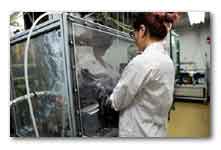|
Manufacturers of toner used in consumer laser
printers and other printing equipment are
incorporating engineered nano materials into their
formulations to improve quality. During the print
jobs it is likely that the particles can be released
in the air.
Researchers at Harvard T.H. Chan School of Public
Health’s Center for Nanotechnology and
Nanotoxicology recently assessed 11 common laser
printers to see if they emitted nanoparticles during
use, and if these particles are harmful..

A Researcher demonstrates the exposure generation
system used to monitor and assess printer emissions
during use.
The Center examines the potential risks and benefits
of nanoparticles used by a variety of industries,
hoping to develop a greater understanding of how
they interact with the body and the environment —
and to provide evidence that will encourage the
burgeoning nanotechnology industry to develop in a
responsible manner.
“With so many products going nano, safety
assessments are needed to safeguard public health,”
said Center Director Philip Demokritou, associate
professor of aerosol physics. “There is a lack of
data on the potential release of these nanomaterials
into the air during consumer use, and their possible
environmental health hazards.”
For the printer study, the researchers developed an
exposure generation system to monitor and assess
emissions during use. As toners don’t list the
presence of nanoparticles on the product labels, the
first step was to confirm that they were indeed
present in formulations currently on the market.
When tests proved positive, the researchers hit
“print” and measured what came out.
The results were surprising. They discovered that
some printers release particles at concentrations
comparable to highly polluted highways.
Further experiments in Demokritou’s lab found that
exposure to the particles elicited an array of
unfavorable biological responses at the cellular
level, including those linked to the development of
respiratory and cardiovascular diseases.
Printer Emitted Particles , PEPs, caused significant
cytotoxicity, membrane integrity damage, reactive
oxygen species (ROS) production, pro-inflammatory
cytokine release, angiogenesis, actin remodeling,
gap cell junctions and epigenetic changes in cells
at doses comparable to those from real world
exposure scenarios representative of inhalation
exposures in the range of 1-200 hours.
We may conclude that laser printer-emitted
engineered nanoparticles can be deleterious to lung
cells and may cause persistent genetic modifications
that could translate to pulmonary disorders.
For more information
Harvard T.H. Chan School of Public Health’s Center
for Nanotechnology and Nanotoxicology
link...
MDN |